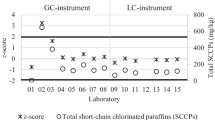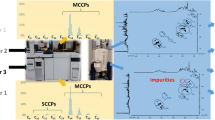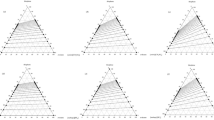Abstract
Chlorinated paraffins (CPs) are straight chain hydrocarbons that are produced as complex mixtures and are used as flame retardants and paint additives. These mixtures are extremely difficult to characterize using conventional chromatographic methods, as conventional gas chromatography results in unresolved complex chromatograms that preclude the identification and quantification of individual congeners or any reasonable assessment of the average carbon chain length. Carbon chain length is an important parameter for assessing physical properties and the toxicity of these materials. We have modified and improved a previously published gas chromatography–flame ionization detector method that uses Pd catalyst held in the gas chromatograph injector to simultaneously dechlorinate the CPs and separate the resulting alkanes. In addition, we have adapted this method to gas chromatography–mass spectrometry. Dehalogenation of other compounds was also studied with this system to investigate potential application to other complex halogenated mixtures.
Similar content being viewed by others
References
Bayen, S., Obbard, J. P., & Thomas, G. O. (2006). Chlorinated paraffins: A review of analysis and environmental occurrence. Environment International, 32, 915–929.
Goodman, W., Tipler, A., Patkin, A., & Prabhu, P. (2009). Nitrogen and hydrogen as alternate carrier gases for GC/MS. Pittcon09.las.perkinelmer.com/.../SPS_Pittcon09-Alternate-Carrier-GCMS-Poster.pdf
Grob, Jr., K., & Neukom, H. P. (1979). Pressure and flow changes in vaporizing GC injectors during injections and their impact on split ratio and discrimination of sample components. Journal of High Resolution Chromatography and Chromatography Communications, 2, 563–569.
Iozza, S., Hüttig, J., Reth, M., Zencak, Z., & Oehme, M. (2006). Analysis of chlorinated paraffins in different biological and non-biological matrices—An overview. Organohalogen Compounds, 68, 2404–2407.
Koh, I., Rotard, W., & Thiemann, W. H. P. (2002). Analysis of chlorinated paraffins in cutting fluids and sealing materials by carbon skeleton reaction gas chromatography. Chemosphere, 47, 219–227.
Korytár, P., Parera, J., Leonards, P. E. G., Santos, F. J., de Boer, J., & Brinkman, U. A. Th. (2005). Characterization of polychlorinated n-alkanes using comprehensive two-dimensional gas chromatography–electroncapture negative ionisation time-of-flight mass spectrometry. Journal of Chromatography A, 1086, 71–82.
Rotard, W., Mailahn, W., Kühn, S., Hermeneit, A., Hillebrecht, S., Kemmlein, S., et al. (1998). Analyse von Chlorparaffinen in Sediment, Muscheln, Krabben aus der Umgebung einer Produktionsanlage. Umedinfo, 7, 19–22.
Santos, F. J., Parera, J., & Galceran, M. T. (2006). Analysis of polychlorinated n-alkanes in environmental samples. Analytical and Bioanalytical Chemistry, 386, 837–857.
Serrone, D. M., Birtley, R. D. N., Weigand, W., & Millischer, R. Fd. (1987). Toxicology of chlorinated paraffins. Food and Chemical Toxicology, 25(7), 553–562.
Sistovaris, N., & Donges, U. (1987). Gas-chromatographic determination of total polychlorinated aromates and chloro-paraffins following catalytic reduction in the injection port. Fresenius’ Journal of Analytical Chemistry, 326(8), 751–753.
Thomas, G. O., Farrar, D., Braekevelt, E., Stern, G., Kalantzi, O. I., Martin, F. L., et al. (2006). Short and medium chain length chlorinated paraffins in UK human milk fat. Environment International, 32, 34–40.
Tomy, G. T., & Stern, G. A. (1999). Analysis of C14-C17 Polychloro-n-alkanes in environmental matrixes by accelerated solvent extraction-high-resolution gas chromatography/electron capture negative ion high-resolution mass spectrometry. Analytical Chemistry, 71, 4860–4865.
Tomy, G. T., Stern, G. A., Muir, D. C. G., Fisk, A. T., Cymbalisty, C. D., & Westmore, J. B. (1997). Quantifying C10-C13Polychloroalkanes in environmental samples by high resolution gas chromatography/electron capture negative ion high-resolution mass spectrometry. Analytical Chemistry, 69, 2762–2771.
Tomy, G. T., Tittlemeir, S. A., Stern, G. A., Muir, D. C. G., & Westmore, J. B. (1998) Effects of temperature and sample amount on the electron capture negative ion mass spectra of Polychloro-n-alkanes. Chemosphere, 37(7), 1395–1410.
Author information
Authors and Affiliations
Corresponding author
Rights and permissions
About this article
Cite this article
Steinberg, S.M., Emerson, D.W. On-line dechlorination–hydrogenation of chlorinated paraffin mixtures using GC and GC/MS. Environ Monit Assess 184, 2119–2131 (2012). https://doi.org/10.1007/s10661-011-2104-9
Received:
Accepted:
Published:
Issue Date:
DOI: https://doi.org/10.1007/s10661-011-2104-9




